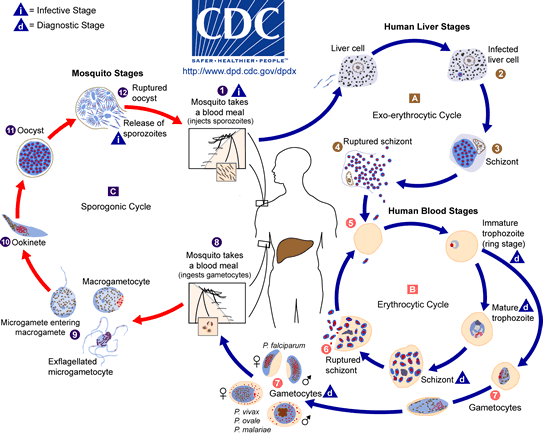QUESTION
What is the pathophysiology of malaria?
ANSWER
Malaria causes disease through a number of pathways, which depend to a certain extent on the species. Malaria is caused by a single-celled parasite of the genus Plasmodium; there are five species which infect humans, being Plasmodium falciparum, P. vivax, P. ovale, P. malariae and P. knowlesi.
All these species are introduced into the human blood stream through the bite of an infected mosquito; the life stage of malaria at this point is called a “sporozoite”, and they pass first to the liver, where they undergo an initial stage of replication (called “exo-erythrocytic replication”), before passing back into the blood and invading red blood cells (called “erythrocytes”, hence this is the “erythrocytic” part of the cycle). The malaria parasites that invade red blood cells are known as merozoites, and within the cell they replicate again, bursting out once they have completed a set number of divisions. It is this periodic rupturing of the red blood cells that causes most of the symptoms associated with malaria, as the host’s immune system responds to the waste products produced by the malaria parasites and the debris from the destroyed red blood cells. Different species of malaria rupture the red blood cells at different intervals, which leads to the diagnostic cycles of fever which characterise malaria; P. vivax, for example, tends to produce cycles of fever every two days, whereas P. malaria produces fever every three.
In addition, Plasmodium falciparum produces unique pathological effects, due to its manipulation of the host’s physiology. When it infects red blood cells, it makes them stick to the walls of tiny blood vessels deep within major organs, such as the kidneys, lungs, heart and brain. This is called “sequestration”, and results in reduced blood flow to these organs, causing the severe clinical symptoms associated with this infection, such as cerebral malaria.
More details on the exact biochemical mechanisms for sequestration and its effect on the pathology of the infection can be found on the Tulane University website.
